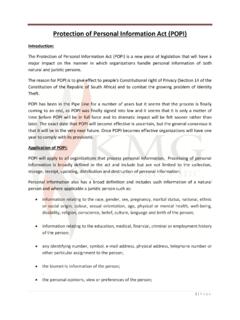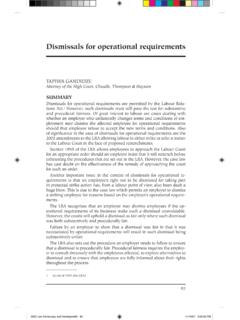Transcription of RETRENCHMENT PROCEDURES FOR EMPLOYERS …
1 1 | Page RETRENCHMENT PROCEDURES FOR EMPLOYERS employing MORE THAN 50 EMPLOYEES INTRODUCTION In my previous Article on retrenchments, the guidelines on RETRENCHMENT PROCEDURES employing less than 50 employees were discussed. This article will focus on the process to be complied with when retrenching more than 50 employees. THE REQUIREMENTS Section 189 A of the LRA1, deals with the process where an employer contemplates retrenchments on a large scale and is applicable with more than 50 employees in their employ. The Labour Relations Act (LRA) places additional obligations on EMPLOYERS involved in large scale retrenchments. Section 189 and Section 189 A of the LRA, should however be read together. Section 189 A applies to all EMPLOYERS with more than 50 employees if2 , - a) the employer contemplates dismissing by reason of the employer s operational requirements, at least i) 10 employees, if the employer employs up to 200 employees; ii) 20 employees, if the employer employs more than 200, but not more than 300 employees; 1 Act 66 0f 1995 2 See section 189 A (1) of the LRA 66 of 1995 2 | Page iii) 30 employees, if the employer employs more than 300, but not more than 400 employees; iv) 40 employees, if the employer employs more than 400, but not more than 500 employees; v) 50 employees, if the employer employs more than 500, but not more than 500 employees.
2 The primary distinction between the two sections is that the employees have the right to strike in an effort to dissuade the employer from retrenching. Either the employer or the employees may compel the other to submit to facilitation by the CCMA or accredited agency during the consultation process. Section 189 A (2) of the LRA, requires EMPLOYERS contemplating RETRENCHMENT to give notice in accordance with section 189 (3) of the LRA3. Facilitation occurs at the request of the employer or any consulting parties representing the majority of the employees targeted for RETRENCHMENT . The procedure in terms of section 189A is as follows: Either party may invoke facilitation of the consultation process before notice of dismissal may be given. If the parties have not chosen facilitation the employer may give notice of dismissal in terms of the BCEA4, 30 days after notice of RETRENCHMENT is given.
3 If facilitation fails the employer may not give a notice of dismissal for minimum of 60 days from the date of the notice. 3 See my previous Article on Basic Guidelines on RETRENCHMENT PROCEDURES for EMPLOYERS employing less than 50 employees. 4 Basic Conditions Of Employment ACT, 75 of 1997 3 | Page If the union or the employees want to challenge the fairness of the reason for dismissal, they must choose whether to refer the dispute to the Labour Court; or whether to strike. A party referring the dispute to the Labour Court must do so within 90 days of the date that the commissioner certified that facilitation has failed. The employer may only lock out employees after strike notice has been given. Once the employees or their union decide to refer the dispute to court they may not strike.
4 If the employees subsequently strike the application to the Labour Court will be deemed withdrawn. INTERIM REMEDY Employees governed by Section 189A have an interim remedy. If they allege that the employer is not complying with a fair procedure, employees may apply to the Labour Court compelling the employer to do so, prohibiting any dismissal until the employer has complied5. CONCLUSION EMPLOYERS and Employees have a legal duty and obligation to comply with the provision of the Labour Relations Act and must effect any RETRENCHMENT process accordingly. The Labour Relations Act has put effective provisions in place to ensure that the unfortunate procedure of a RETRENCHMENT is fair. Article by Ferahnaaz Abdool Sattar Attorney - Litigation/Labour Law KMG & Associates Inc. LLB(UP) 5 See Section 189 A (13) of the LRA Act 66 of 1995











